
God’s Design for Bioluminescence
News to Know
Abstract
Secrets of Shining Mushrooms Revealed
News Sources
With the coming of night in Brazil’s Coconut Forest, bioluminescent mushrooms dial up their green glow. They attract insects that can carry spores far and wide under the nearly windless canopy. Until recently many scientists thought their dim glow was a random byproduct of mushroom metabolism, related perhaps to the digestion of decaying wood. “Circadian Control Sheds Light on Fungal Bioluminescence” published in Current Biology, however, offers the first solid evidence that mushroom bioluminescence is regulated and purposeful.

Here the bioluminescent mushroom Neonothopanus gardneri is seen by day, being visited by a rover beetle (inset), and by night, when it intensifies its green glow. Image reproduced from A. Oliveira et al., “Circadian Control Sheds Light on Fungal Bioluminescence,” Current Biology 25, no. 7 (March 30, 2015): 964–968, http://dx.doi.org/ 10.1016/j.cub.2015.02.021.
Glowing with Purpose
Bioluminescent mushrooms are the only fungi that make their own light, but why they do is an age-old mystery. Aristotle (384–322 BC) and Pliny the Elder (AD 23–79) recognized that the glow they imparted to decaying wood was not fire, and a 17th century Dutch physician reported that Indonesian natives carried bioluminescent mushrooms to light their way through dark forests.1 But how did this serve the mushrooms?
At latest count, only 71 of the 9,000 species of gilled mushrooms glow. In some the glowing parts are mostly hidden underground,2 but light from “flor de coco” (literally “coconut flowers”)—the large Neonothopanus gardneri mushrooms growing beneath Brazilian coconut palms—is easily seen. Locals say it varies, appearing greatest during humid nights following hot days with afternoon showers.3 Brazilian scientists collaborating with a team from Dartmouth’s Geisel School of Medicine have now proven that the luminescent levels of those light-producing molecules follow a nightly cycle that attracts lots of insects.
Calibrating the Mushroom Clock
The scientists first had to train laboratory-grown mushrooms to recognize night. Mushrooms cannot detect light, but the scientists found that within two days the mushrooms had set their clocks by the nightly fall in temperature. The mushrooms cranked up their light output about 10 hours after dark. The pattern varied only slightly, depending on the temperature. The mushrooms’ internal clocks, once set, intensified their light output about every 22 hours even when kept in total darkness for several days.
Having determined the standard by which mushrooms tell time, the team confirmed that the mushrooms’ circadian clock regulates the actual chemical reactions that generate their cool glow. While light-making biochemistry varies greatly across the biological world, most such living lights4 are emitted when some sort of luciferase enzyme5 and an energy-carrying molecule (ATP, NADH, or NADPH) oxidize an organic molecule called a luciferin. After the trained Brazilian mushrooms were placed in the dark, the scientists periodically extracted their enzymes and luciferins. Despite days in total darkness, the enzymatic activity and luciferin concentration periodically rose three- to fourfold, cycling every 22 hours and peaking six hours after the normal “preset” nighttime.6 Thus, the chemical reactions that produce the light cyclically become most active just a few hours before the time of maximal luminescence, providing “a molecular basis for the observed rhythm in luminescence.”7
The fact that mushrooms have a mechanism regulating light output implies the light serves a purpose. As coauthor Jay Dunlap of the Geisel School of Medicine explains, “Regulation implies an adaptive function for bioluminescence.”8
Seeing Green
All insects are equipped to see green—the color of choice in fungal lightwear—though why insects are attracted to light in the first place remains a mystery.
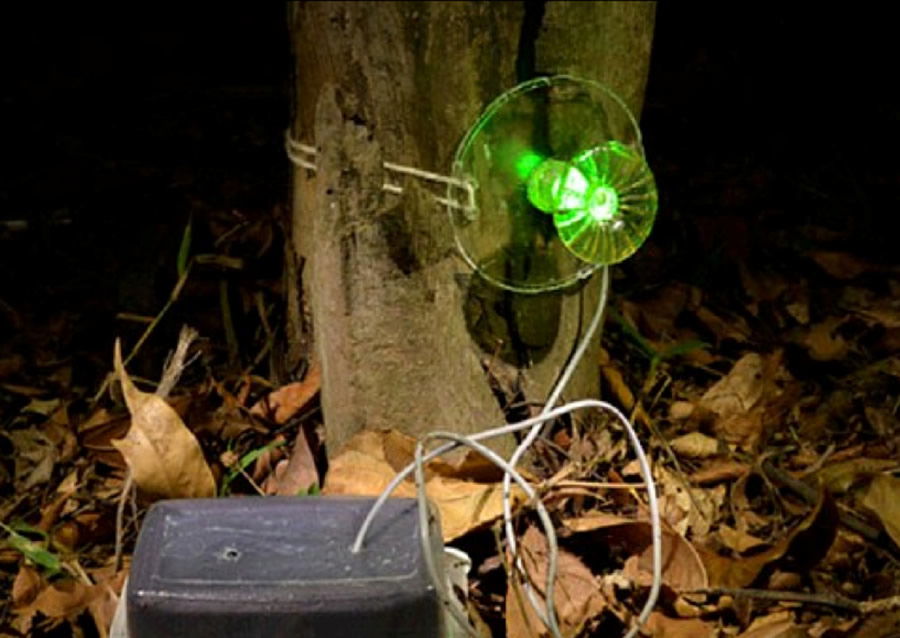
Image reproduced from Oliveira et al., “Circadian Control . . .”
When acrylic mushrooms emanating LED light comparable in color and intensity to that produced by real mushrooms were placed in the dark forest, the scientists found that bugs, beetles, flies, wasps, and ants flocked to their green glow. Rove beetles in particular are frequent visitors to these mushrooms and are thought to nibble at the fungi they frequent. Therefore, if such insects also provide a service to the mushrooms, then their relationship is an example of a mutualistic symbiosis where everyone benefits from the long-term relationship. Speculating that bioluminescence enhances mushroom spore dispersal, Cassius Stevani of Brazil's Instituto de Química-Universidade de São Paulo says, “It appears that fungi make light so they are noticed by insects that can help the fungus colonize new habitats.”9 Stevani and colleagues explain that nighttime is the best time to shine:
Fungal bioluminescence is too dim to be perceived by animals during the day but is readily perceived at night (even from smaller and less bright mushrooms than N. gardneri), so rhythmic control luminescence would be an attractive means to eliminate wasting energy through daytime luminescence. . . .
Hence, our data are consistent with the hypothesis that nocturnal clock-controlled bioluminescence renders N. gardneri more noticeable to insects and thus provides a selective advantage in spore dispersal not afforded to non-luminescent species.10
Many Facets of Living Light
Bioluminescent species include fireflies, bony fish, millipedes, bacteria, dinoflagellate plankton, jellyfish, comb jellies, krill, and of course mushrooms. The catalogue of bioluminescent organisms stretches across 16 phyla and about a third of the classes in each. And while most comb jellies glow, only a small fraction of most taxonomic groups produce light. Some species include both luminescent and non-luminescent individuals.
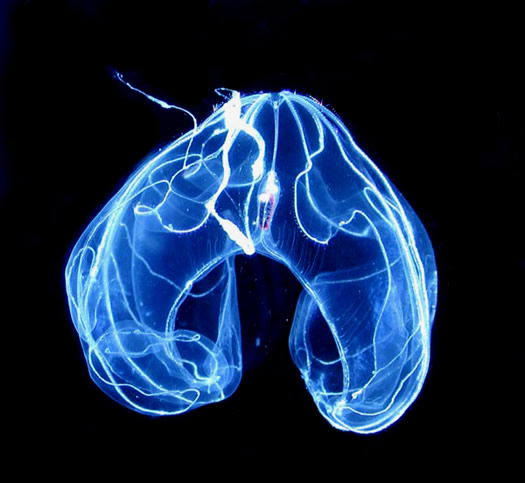
Bathocyroe fosteri comb jelly. Image by Marsh Youngbluth, reproduced from Ocean Explorer.
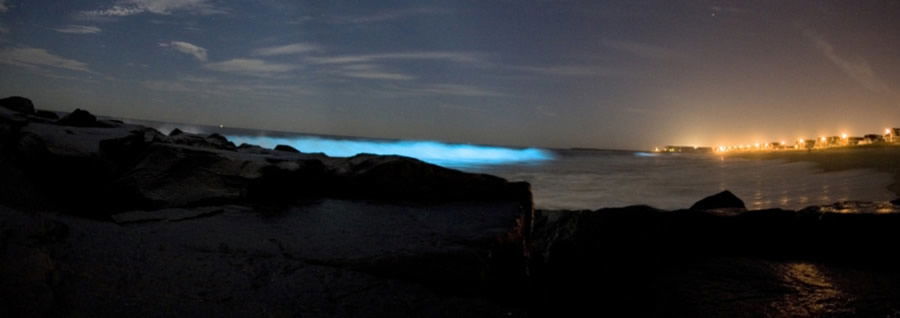
Bioluminescent dinoflagellates light up breakers off the coast of Manasquan, New Jersey, in this photo. Dinoflagellates are a sort of plankton, and at least 18 dinoflagellate genera contain bioluminescent species, lighting up at night and when agitated. Image reproduced from user “Yikrazuul,” Wikimedia Commons.
Bioluminescence, whether produced by animals it directly benefits or bioluminescent bacteria living in symbiosis, helps many animals hunt, hide, or reproduce. Pouches under the eyes of the flashlight fish (Photoblepharon sp.), for instance, are home to bioluminescent bacteria that attract crustaceans the fish consumes. It also turns the lights on to communicate with potential mates. But the flashlight fish escapes becoming dinner by blinking off the lights with a membranous cover and darting off in a different direction.
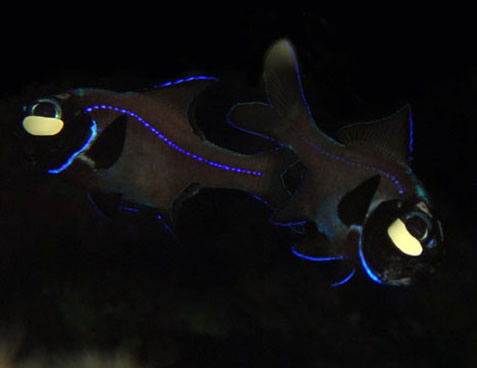
Two flashlight fish (Photoblepharon steinizi). Image by Abe and Haneda (1973), reproduced from Bionique.
Many species of fireflies light up, often with species-specific flash patterns that help locate mates or, in the case of female fireflies of the Photuris genus, that lure male fireflies to be eaten.

Photinus pyralis firefly. Image reproduced from user “Yikrazuul,” Wikimedia Commons.
The Bermuda fireworm (Odontosyllis enopla) has its own flashy mating ritual. The females rising from the sea bottom swim in a circle of light that attracts males. The males, with vision optimized for the females’ wavelength (~515 nm), enter the circle and respond with their own bursts of light as they make their contribution to the reproductive process, fertilization occurring in the water so the species can continue.11
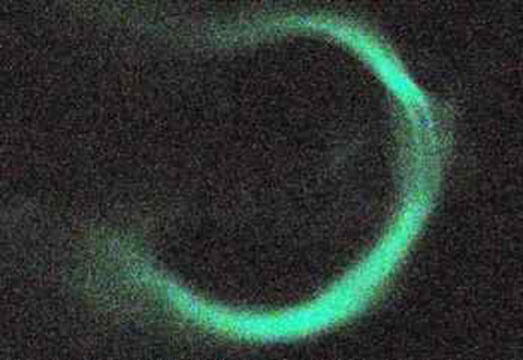
Image reproduced from Bermuda Attractions.
Some marine animals use the light they generate to leave a decoy while they escape. For instance, some species of segmented scale worms drop luminescent scales as countermeasures when attacked. The North Sea marine worm Eusyllis blomstrandi has flashing luminescent structures in each segment. When threatened it breaks itself in half, switches off the lights in the front portion (which later regenerates), and leaves the tail shining with continuous brightness to interest predators until its light dies away.12 And the deep-dwelling squid Octopoteuthis deletron can wriggle its bioluminescent arm tips to lure prey or detach those tips when attacked, leaving them glowing and twitching as the squid escapes under cover of an inky cloud.

Monterey Bay Research Institute, from video of Octopoteuthis deletron squid encountering a lighted bottle brush (left) and leaving detached bioluminescent tentacle tip behind (right). Images reproduced from MBARI (2008), “Disarming Deep-Sea Tactics,” AAAS Science.
Defense can take a variety of other forms. New Zealand’s freshwater limpet Latia neritoides gums up its attackers with sticky green goo, perhaps making the predator itself an object of interest to other predators.13 Glowing as a warning to potential predators, eight of the 12,000 species of millipedes, such as Motyxia sequoia, glow as a warning to potential predators and increase their light intensity when disturbed. Though millipedes also produce poisonous hydrogen cyanide, millipedes that do not luminesce are attacked twice as often, suggesting the glow deters predators with good memories.14

This is a model of Motyxia sequoia, the brightest species of bioluminescent millipede, at the American Museum of Natural History. Image by Janine and Jim Eden, reproduced from Wikimedia Commons.
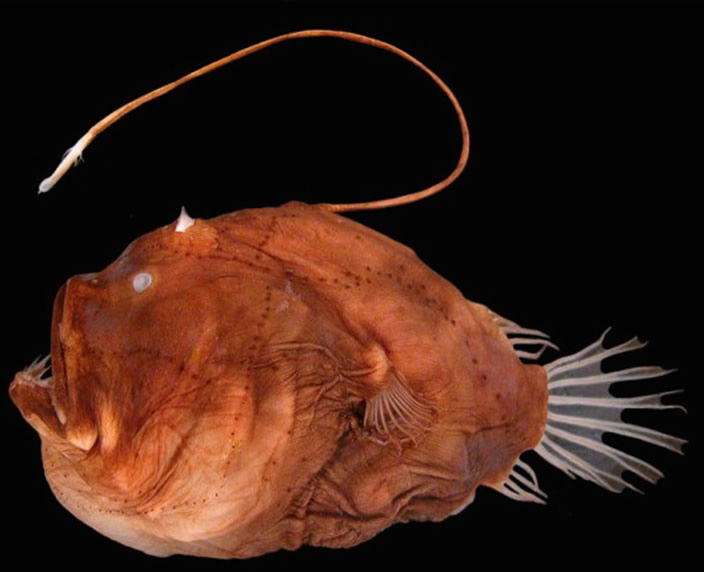
Deep sea anglerfish (Bufoceratias wedli) with bioluminescent lure. Image reproduced from Masaki Miya et al., “Evolutionary History of Anglerfishes . . .” BioMed Central, figure 2.
Switching on the lights can paradoxically attract prey or provide camouflage. Female anglerfish carry a luminescent lure of bioluminescent Vibrio fischeri bacteria dangling above their mouths in the deep dark ocean.
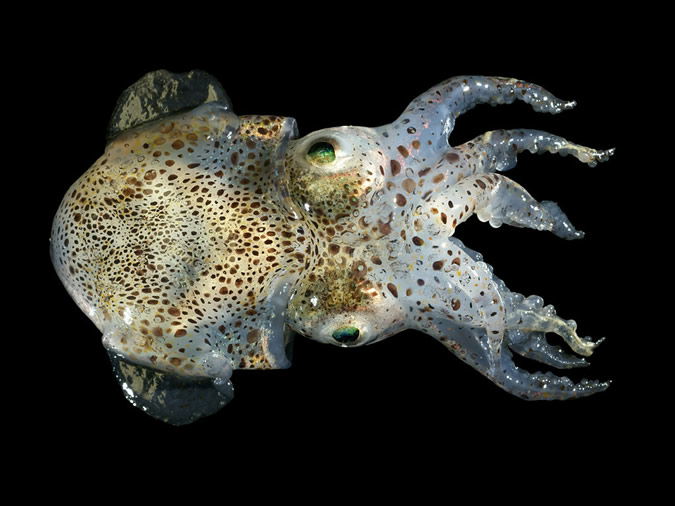
Bioluminescent bobtail squid. Image by Hans Hillewaert, reproduced from Wikimedia Commons.
Living light produced by the same bacteria serve this nocturnal bobtail squid as camouflage in the moonlight just as bioluminescence enables other marine animals to hide by matching their light to the daytime sky above.
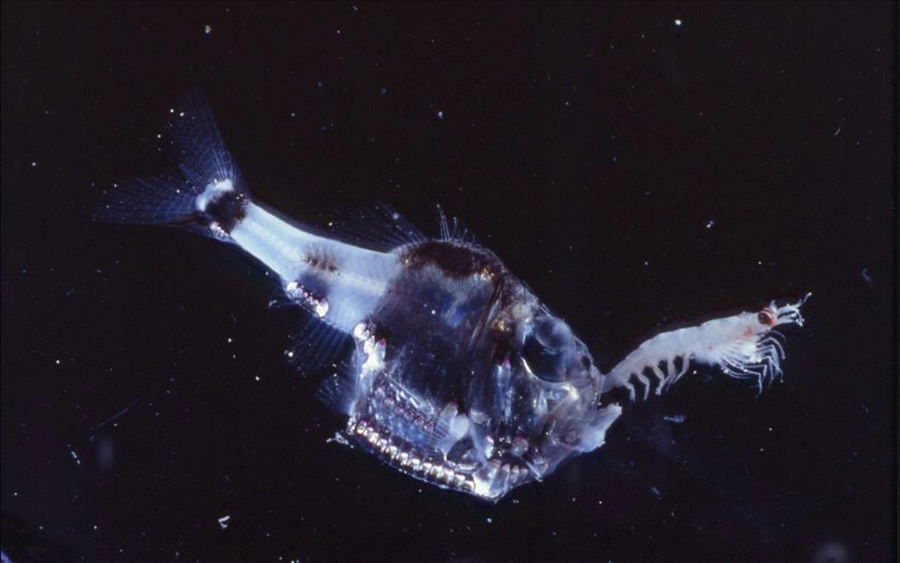
Hatchetfish (Argyropelecus hemigymnus). Image reproduced from user “Edd48,” Wikimedia Commons.
Hatchetfish, for instance, regulate the color and intensity of light from a species-specific pattern of photophores on their undersides to mask their silhouette against the sky above, rendering them invisible from below. Several species of small sharks do the same, and some use their super-sensitive vision to help them match their lights to the sky above.
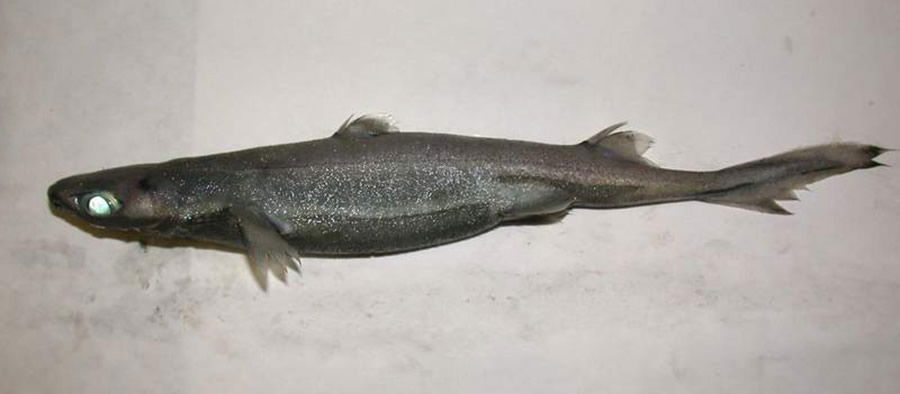
This small velvet belly lantern shark Etmopterus spinax has photophores lighting its underside to camouflage it against the sky above. Image reproduced from user “Etrusko25,” Wikimedia Commons.
The purposes of some life lights are more cryptic. The railroad worm, the larva of the beetle Phrixothrix sp., glows in two colors—red for the head and green for the body. Perhaps this confuses predators, but no certain reason for this is known.
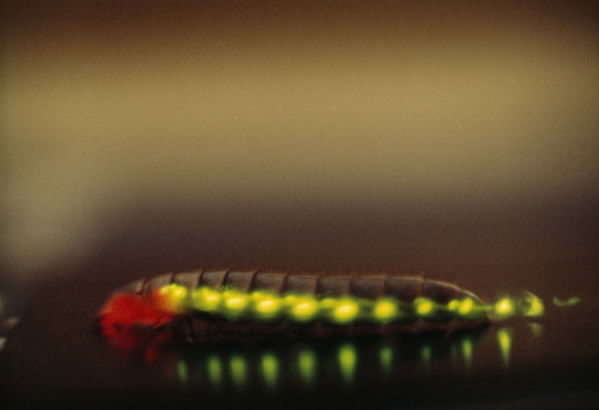
Railroad worm. Image by Robert Sisson/National Geographic Creative, picture id 618662.
And concealed within the hollows they drill into coastal European rocks, the common piddock (Pholas dactylus), a clam-like mollusk, produces blue-green slime as well as light from symmetrical patches on its body. While Pliny the Elder marveled that the mouths of people feasting on these raw mollusks dripped with glittery goo,15 the value of the bioluminescence for the bivalve has yet to be determined.

Shell of Pholas dactylus from the Museo Civico di Storia Naturale di Milano, a bioluminescent mollusk that was a popular party food in Roman times. Image reproduced from user “Hectonichus,” Wikimedia Commons.
The most consistent thing about bioluminescence is the diversity of organisms that exhibit it and the variety of purposes for which they use it. And the biochemistry that makes bioluminescence happen is as diverse as the organisms. All forms of bioluminescence require some form of oxygen, and that is where the consistency ends. Comb jellies, for instance, do not even use molecular oxygen to produce light, but instead use oxygen from an enzyme-attached peroxide stored in light-producing cells. Light deactivates the enzymatic system that supplies oxygen, so unlike most bioluminescent organisms, comb jellies go dark in the presence of light.16
Diverse Design or Evolutionary Confusion?
Bioluminescence remains a riddle for evolutionary scientists. Neither its biochemistry nor its biodiversity follows a discernible pattern. How could so many different versions of bioluminescent biochemistry evolve, and why? And why, evolutionary scientists wonder, would some bacteria evolve to spend their energy making light? There seems to be no rhyme or reason why certain organisms produce light and others—even those similar in every other way—don’t. As bioluminescence experts write, “The distribution of bioluminescent organisms in the phylogenetic tree of life is very intriguing, since there is no apparent relationship or rule for their distribution.”17
The biochemistry of bioluminescence in some organisms, like fireflies and bacteria, is well understood, but in many it is still being worked out. Yet in all there is an element of irreducible complexity, for unless all essential molecules are present, light is not produced. Scientists still aren’t sure just what molecules serve as the luciferases and luciferins in mushrooms, but a recent study showed that the light-producing molecules in the four different types of bioluminescent mushrooms compatibly cross-react with each other.18 Therefore, evolutionary scientists believe that while bioluminescence had to evolve 50 or more times in evolutionary history, it only had to evolve once for fungi.
Because utilization of some form of oxygen is about the only thing all bioluminescent organisms have in common, evolutionists try to relate the evolution of bioluminescence to the widespread appearance of oxygen on Earth. Evolutionists assume the early Earth that cradled life’s beginnings was devoid of oxygen until cyanobacteria produced enough to accumulate. Because oxygen can paradoxically be toxic to lots of life’s biochemical processes, some evolutionists suggest luciferase-luciferin systems evolved to decrease oxygen toxicity, light being an incidental byproduct. But since other protective antioxidants also evolved, they surmise, bioluminescence was lost in most organisms over time, as it was no longer needed or not adequate to do the job in the face of rising oxygen levels.19 The evolution of vision provided a selective advantage allowing bioluminescence to be retained, the story goes, in those organisms that might have evolved it early on and then found other uses for the light they made.
Since visible light would offer no selective advantage without something to see it, bioluminescence evolution can even predate the evolution of vision—another area rooted in worldview-based speculation. (Learn more about it from Dr. Tommy Mitchell in Evolution: The Eyes Don’t Have It!) In other words, while some evolutionists believe that various bioluminescent chemical systems evolved to cope with oxygen, once that function was superseded, only a vision-related function would provide the selective advantage to keep such bioluminescent systems from disappearing. For instance, evolutionary scientists assume that insects must have evolved the ability to see ultraviolet, green, and blue colors by the Devonian age because all insects can see these colors. Thus evolutionists have pushed the convergent evolutionary origins of bioluminescence far enough back in history to get it on the evolutionary palette of many different sorts of organisms and then depended on vision-related functions to offer a selective advantage to keep it from disappearing in a random assortment of organisms.
Of course all such musings about an inhospitable early Earth, a Great Oxidation Event, the evolution of life from chemicals, and the presumed increase in the complexity of living things through random natural processes are all worldview-based ideas that are not only unverifiable by observational science, but also reject the eyewitness account of the six-day creation God provided in the Bible. (Many articles on this website explore these topics.) And the notion that vision arose through evolution is equally rooted in untenable speculations. Furthermore, the fact that for each of the 50 or so times bioluminescence had to evolve it would have had to produce precisely matching molecular parts on each luciferin-luciferase pair in addition to effective energy-saving mechanisms to switch the lights on and off begs credulity for the evolutionary just-so story.
Random evolution through natural processes, unsupported as it is by observable mechanisms in biology and steeped in unverifiable worldview-based assumptions, cannot account for the biodiversity of bioluminescence or the plethora of biochemical routes by which diverse organisms produce and regulate their light. But a wise Creator, who like a good engineer has designed many variations of this useful ability, can. Bioluminescence even helps many animals cope with this cursed and fallen world. Bioluminescence in its many forms and functions is a grand illustration of God’s wise design.
Further Reading
For More Information: Get Answers
Remember, if you see a news story that might merit some attention, let us know about it! (Note: if the story originates from the Associated Press, FOX News, MSNBC, the New York Times, or another major national media outlet, we will most likely have already heard about it.) And thanks to all of our readers who have submitted great news tips to us. If you didn’t catch all the latest News to Know, why not take a look to see what you’ve missed?
(Please note that links will take you directly to the source. Answers in Genesis is not responsible for content on the websites to which we refer. For more information, please see our Privacy Policy.)
Footnotes
- Aristotle recorded his observations in De Anima (book II, chapter 7). Pliny the Elder described the sweet taste and pharmacological efficacy of bioluminescent fungi on decaying trees in France in Historia Naturalis, and he also wrote about bioluminescent marine life, such as the tasty mollusk Pholas dactylus. Physician and merchant Georg Eberhard Rumphius (1637–1706), the Dutch consul of Amboine (Moluccas, Indonesia) recorded his observation in his six-volume botanical compendium Herbarium Amboinense.
- The light-emitting parts of bioluminescent mushrooms vary. And most bioluminescent mushrooms consume decaying wood, becoming an important part of nature’s recycling system. Armillaria, however, can attack living trees. Only the hidden mycelia of the five bioluminescent Armillaria species make light, so it is unlikely that bioluminescence contributes to the spread of spores from the seasonally appearing fruiting body in these particular mushrooms.
- A. Oliveira et al., “Circadian Control Sheds Light on Fungal Bioluminescence,” Current Biology 25, no. 7 (March 30, 2015): 964–968, http://dx.doi.org/10.1016/j.cub.2015.02.021.
- This article concerns only bioluminescence, a process by which organisms produce visible light without significant heat as a result of a chemical reaction. This differs from fluorescence, a process by which corals and some other organisms absorb light energy at one wavelength, such as an ultraviolet one, and emit it as visible light.
- Luciferase enzymes vary greatly, though they all catalyze the reaction of some form of oxygen with a luciferin molecule to produce light. And some bioluminescent organisms don’t even use a luciferase-luciferin system but instead use a different photoprotein. All bioluminescent reactions do require oxygen in some form and an energy source.
- Oliveira et al., “Circadian Control . . .” http://dx.doi.org/ 10.1016/j.cub.2015.02.021.
- Ibid.
- “Glowing Mushrooms Use Bioluminescence to Attract Insects . . .” BioQuick News, March 20, 2015, http://www.bioquicknews.com/node/2445.
- Ibid.
- Oliveira et al., “Circadian Control . . .” http://dx.doi.org/10.1016/j.cub.2015.02.021
- Thérèse Wilson and J. Woodland Hastings, Bioluminescence: Living Lights, Lights for Living (Cambridge, MA: Harvard University Press, 2013), 81.
- S. A. Zömer and A. Fischer, “The Spatial Pattern of Bioluminescent Flashes in the Polychaete Eusyllis blomstrandi (Annelida),” Helgoland Marine Research 61(2007): 55–66, doi: 10.1007/s10152-006-0053-4.
- Wilson and Hastings, 88.
- P. Marek et al., “Bioluminescent Aposematism in Millipedes,” Current Biology 21, no. 18 (September 27, 2011): R680–R681, doi:10.1016/j.cub.2011.08.012.
- “The Glowing Clams of Great Britain,” Atlas Obscura, accessed May 26, 2015, http://www.atlasobscura.com/places/glowing-clams-great-britain/.
- Wilson and Hastings, 86.
- C. Stevani et al., “Current Status of Research on Fungal Bioluminescence: Biochemistry and Prospects for Ecotoxicological Application,” Photochemistry and Photobiology 89, no. 6 (2013): 1318–1326, doi:10.1111/php.12135.
- Oliveira et al., “Evidence that a Single Bioluminescent System Is Shared by All Known Bioluminescent Fungal Lineages,” Photochemical and Photobiological Sciences 11 (March 27, 2012): 848–852, doi:10.1039/C2PP25032B.
- This “oxygen detoxification” hypothesis and the idea that it evolved independently and very early in some lineages without the necessity of a vision-related function is discussed in chapter 9, “The Origins and Evolution of Bioluminescence” in Wilson and Hastings, Bioluminescence, 125–132.
Recommended Resources

Answers in Genesis is an apologetics ministry, dedicated to helping Christians defend their faith and proclaim the good news of Jesus Christ.
- Customer Service 800.778.3390
- © 2024 Answers in Genesis




